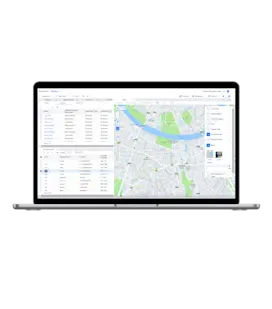En vedette dans cet article
Top 10 Mistakes To Avoid When Choosing Truck Route Optimization Software
Top 10 Mistakes To Avoid When Choosing Truck Route Optimization Software
6 Août 2024
Aptean Staff Writer
Have you considered that choosing the right route planning system can reduce your transportation costs by up to 30%?
And that’s just the first of many benefits truck route optimization software offers including improved efficiency, reduced planning time and enhanced customer satisfaction. The best systems also scale with your business growth, offer real-time execution management, integrate seamlessly with other systems and enhance driver satisfaction by accommodating their needs.
However, making the wrong software choice can lead to wasted resources and missing out on these benefits. Your investment in route optimization software presents a significant opportunity for your business, but there are many pitfalls to be aware of and thoroughly preparing for your decision can make all the difference.
This blog will guide you through how to avoid ten common mistakes companies make when selecting truck route optimization software—helping you choose a solution that meets your current needs and propels your business toward future growth.
Let’s dive in and ensure your business has the information it needs to secure a first-time return on investment.
1. Choosing Software That Lacks Flexibility
Every business has unique needs which means that choosing truck route optimization software that cannot be adjusted to your operation can severely limit its effectiveness. For instance, do your planners have local knowledge that should be digitized and accounted for in your route plans? Can certain customers only accept deliveries within specified time windows, or must certain products be delivered first on a route?
If the routing rules of your chosen software cannot be customized to match your specific business needs, you’ll be forced to work around its limitations leading to inefficiencies, missed customer preferences and increased costs.
So, when evaluating, look for route planning software that allows you to configure settings, customize reports and adapt to new challenges without needing extensive modifications or additional tools. This ability to tailor and amend configurations to your needs ensures that the software continues to serve your business effectively as it grows and evolves.
By choosing flexible software, you can avoid being locked into rigid processes that may not align with your long-term goals, reassuring you that the system remains an asset rather than a liability.
2. Overlooking Scalability
When selecting truck route optimization software, the promise of scalability is a pivotal factor. As your company grows, your logistical needs are likely to become more complex, necessitating software that can keep pace with this expansion. A truly scalable solution can seamlessly adapt to these increasing demands, relieving the risk of disruptive overhauls or costly new systems.
With a cloud-based routing system, your business can easily add more users, increase data storage and access processing power without the constraints of physical infrastructure. Such flexibility is crucial for managing growing fleets, expanding service areas or handling increased delivery volumes. Moreover, cloud solutions often provide easier updates so you’re always able to leverage the latest features.
The best route optimization software should also be modular and have a cost-effective approach to meeting your evolving business needs. You can start with the core features you need and add more capabilities over time as your business evolves. For instance, you might begin with essential route planning and later unlock additional features like real-time traffic performance and execution management. This modularity not only spreads out costs over time but also allows your system to provide additional value as you expand your operations.
As your business grows, the number of people needing access to the route optimization software will likely increase. Look for software that offers flexible user management, where you can assign roles and permissions according to different job functions. This ensures that as your team expands, everyone has the access they need to perform their roles effectively, without the need for extensive training or support.
3. Focusing Solely on Cost
Budget considerations are important but if you lose yourself in comparing costs, you risk missing out on other valuable features and functionalities. Or, even worse, needing to switch to a new system shortly down the line—wasting time, money and resources.
Opting for the cheapest solution may result in inadequate support, limited integration capabilities and a lack of scalability, ultimately leading to higher operational costs and inefficiencies in the long run. Therefore, it's essential to evaluate the total cost of ownership (TCO), including implementation, training and maintenance costs, rather than just the initial purchase price.
Not only that but the best truck route optimization systems can significantly impact your bottom line. Investing in proven and advanced software that offers comprehensive features can substantially cut fuel and labor costs, optimize vehicle utilization, help you avoid fines and even aid you in winning more business. As such, it's crucial to balance initial cost considerations with the potential return on investment and long-term benefits the right software can provide.
For more information, check out Routing and Scheduling Software: Where the Savings Come From.
4. Neglecting User-Friendliness
The effectiveness of any software depends largely on how easily it can be used by those who interact with it every day. Neglecting to account for user-friendliness can lead to low adoption rates, increased training costs and operational inefficiencies.
Complex and unintuitive software interfaces will frustrate your staff and can lead to mistakes and delays in route planning and execution. Instead, selecting software that prioritizes step-by-step functions, familiar formatting and accessibility will help you maximize smooth onboarding and reduce the learning curve for your team. In short, don't underestimate the power of user-friendly software—in your business, where time is of the essence, it can significantly improve productivity and operational efficiency, as well as helping improve staff retention.
But how do you go about assessing the accessibility and user-friendly credentials of a potential system before you sign on the dotted line? There are two main ways you can avoid this pitfall—getting a live demo and reviewing customer references. As we’ll discuss later, a demo is a crucial step in evaluating the real-world capabilities of truck route optimization software and is also an opportunity to assess if the interfaces and functions your staff will use every day are straightforward and easy to adopt. It’s also a good idea to garner customer references, testimonials and peer feedback so you can hear first-hand what the user experience is like.
5. Underestimating Customer Support
Reliable customer support is critical in successfully implementing and using route optimization software. Underestimating its importance, both in the implementation and lifetime of your software, can lead to configuration mistakes, technical issues, slow responses and overall dissatisfaction. That’s why it's essential to choose a provider that offers comprehensive support, including 24/7 availability, knowledgeable staff and multiple channels for assistance.
Just as a problem in a production scheduling system can lead to massive downtime and loss of profit in manufacturing, delays or errors in route planning can lead to significant financial losses and reputational damage for your distribution operation—that's why effective customer support is invaluable. With it, you can rest easy knowing that issues and disruptions will be resolved quickly and instead focus solely on your core business activities.
What’s more, by choosing a vendor that offers comprehensive lifetime software support and consultation, you can ensure you always have an expert in your corner. Whether you want to reassess your route planning and fleet management as your business evolves, utilize new software features and modules, or train up new users, ensuring you will have the right level of support available to you down the line is crucial to consider before you make your final software decision.
6. Not Considering Real-Time Execution Management
Real-time route execution and live management are essential for comprehensive route optimization, enabling you to respond quickly to changing conditions, such as traffic, weather and customer demands. Not considering these features can result in missed deliveries, disgruntled customers and reduced efficiency as your optimized plans come unraveled in the execution stage.
Instead, with the right truck route optimization software, you can provide your transportation teams with real-time dashboards, key performance indicator tracking and planned vs actual route data—so they have all the visibility and control to keep your schedules on track and efficient. Real-time route management and live data guarantees reliable deliveries and efficient use of resources, making this a must-have when evaluating potential systems.
Plus, by collecting this wealth of real-time data, including actual hours worked by drivers and accurate driver detention times, the best route planning software enables you to improve future route plans. By leveraging real-world data, you can identify patterns over time and breakdown silos between planning and transportation teams. This helps you create a continuous improvement loop that maximizes route optimization, reduces fuel consumption and enhances overall service levels.
Choosing software that lacks robust real-time execution and live management capabilities can put you at a competitive disadvantage as it limits your ability to make informed decisions and quickly adapt to changes.
Looking for more? Discover how truck route optimization software creates a cycle of continuous improvement, reduces driver detention time and empowers your route execution.
7. Overlooking the Needs of Your Drivers
Truck drivers are the backbone of your operation so your route optimization software must support their needs—particularly in light of the growing driver shortage.
A common complaint leveled at the truck driving industry is the irregular hours and lack of work/life balance. To counter this, the right system can help you provide shifts patterns that suit your drivers' needs. For example, if Driver A prefers to do regular day shifts and be home each evening, while Driver B would rather do long haul stints, where possible you can feed these accommodations into the system to boost morale and reduce turnover while still using your resources most cost-effectively.
Additionally, you should look for software that provides resource management functionality. These features can account for driver availability, vacation time, skills and certifications when creating optimized routes so that workloads are equally balanced, and each driver feels they are valued for their individual skillset. Plus, this ensures you maximize resource utilization and reduce overtime costs—so it’s a win-win.
Don’t forget to also look for vendors that provide integrations with other software systems that can make your driver’s working life easier, such as electronic proof of delivery software to streamline on-the-road tasks and data collection. Because ultimately, a content driver is more loyal and productive, so ensuring any logistics tool you’re evaluating supports them is crucial to success.
Learn more on combatting driver shortages with our blog: Attracting Young Drivers to Trucking.
8. Failing To Assess Vendor Reputation and Experience
Your logistics software investment isn’t just about the bells and whistles of the system, it’s about the quality of the partner, too. Vendor reputation and experience are critical factors in choosing route optimization software. Failing to assess these aspects can lead to partnering with a provider that doesn’t have the know-how to solve your specific operational challenges, or the stability to support your business long term.
On the other hand, a reputable vendor with a proven track record can offer reliable, high-quality software and support, ensuring smooth implementation and ongoing use. Your chosen supplier should not only be an expert in their own software, but they should be an expert in your field—enabling them to offer best practice guidance that is founded on years of experience empowering businesses like yours to succeed.
To evaluate your potential vendors for these qualities, you need to ask the right questions. Can they provide testimonials and customer references of businesses in your industry, region or facing a similar challenge? Are they a leader in the industry with a reputation for excellence? Do they have a development pipeline of product enhancements to keep their software cutting-edge? All in all, when interacting with each company on your shortlist try to gauge if they are knowledgeable and skilled enough to provide you with the confidence and ease you need to make this big decision.
9. Ignoring Integration Capabilities
As you know, seamless integration between various systems is crucial in your business. Your route planning software is no different. Ignoring the need for integration capabilities can lead to data silos and inefficiencies, as manual data entry becomes necessary to bridge gaps between your routing system, enterprise resource planning (ERP) and customer relationship management (CRM) systems.
Efficient data flow between these platforms enables better decision-making, reduces errors and saves time—ultimately leading to more streamlined operations and cost savings. So be sure to consider and plan time for these integrations as part of your shortlisting and implementation phases. In particular, be on the lookout for vendors that have experience integrating with your existing systems and provide standardized integration methods.
Moreover, integration capabilities allow for the real-time data sharing we covered earlier—this is essential for optimizing routes, tracking deliveries and ensuring timely customer communication. For this, you’ll need integrations with your telematics systems and proof of delivery software. In an era where customer expectations are higher than ever, the ability to provide accurate and up-to-date information can significantly enhance customer satisfaction, therefore, choosing route optimization software that lacks robust integration features can hinder your ability to stay competitive and responsive.
10. Not Evaluating Software With a Live Demo
Finally, we come to a step that can help you evaluate many of the considerations on this list: a live software demo. Committing to software without seeing it in action first—in a live environment, not only a pre-recorded tour—can result in choosing a solution that doesn't align with your business needs or operational workflows. This can lead to inefficiencies, increased costs and even potential disruptions to your operations.
Instead, a demo allows you to assess the software's performance, usability and functionality, ensuring it meets your specific requirements and mitigates these risks. It also lets you compare each vendor’s claims with their real-world capabilities—a vital step given the wide range of software options available today, all touting similar features and benefits.
In addition, a live demo enables key stakeholders to be involved in the evaluation process, gather feedback and identify potential issues before making a significant investment. This helps ensure complete buy-in across your teams, boosting eventual software adoption and integration.
The additional benefit of a live demo is that it offers the opportunity to see how the software handles real-world scenarios specific to your operations. This personalized experience can reveal how well the software adapts to your unique routing challenges, such as differing vehicle types, last-minute changes or complex route planning needs—providing insight into the ease with which your team can integrate it into daily workflows. By thoroughly exploring these aspects during the demo, you can avoid surprises down the line and confidently invest in a solution that empowers you to support and optimize your business processes.
Read more on The Importance of a Live Logistics Software Demo

Why Aptean Is Your Perfect Route to Success
Choosing the right truck route optimization software for your business is a tricky decision. Avoid the common pitfalls we’ve discussed here and you’ll set your business up for success. The easiest way to steer clear of these mistakes is to combine market-leading software with a best-in-class vendor.
That’s what we pride ourselves in offering, here at Aptean. With decades of experience at its technological forefront, we understand the challenges of modern logistics. As a result, we’ve built a truck route optimization system that stands head and shoulders above the competition.
By leveraging advanced algorithms, real-time data and configurable features, Aptean Routing & Scheduling software ensures that your distribution operations are not just efficient and cost-effective, but also delivering excellent customer service and driver satisfaction as standard.
Our software can scale to meet your demands without compromising performance, giving you the confidence to focus on your core business, knowing your logistics operations are optimized for success. With 24/7 availability and a team of experts ready to assist you, Aptean ensures you have the help you need when needed. This support is crucial in maintaining operational efficiency, minimizing downtime and maximizing investment.
Finally, we also provide a full suite of complementary products to optimize your end-to-end logistics activities—including our full multi-carrier transportation management system, electronic proof of delivery software and advanced home delivery platform.
Let Aptean be your trusted partner in navigating the complexities of modern logistics. Contact us today to schedule a demo and see how our route optimization software can streamline your operations and boost your competitive edge.
Related Content





Prêt à transformer votre entreprise ?
Nous avons les solutions TMS spécialisées dont vous avez besoin pour relever les défis de votre secteur.



